Alerting Communicators of America: Difference between revisions
(Created page with "Alerting Communicators of America, commonly referred to as ACA for short, was a siren manufacturer preceded by Biersach & Niedermeyer Co., and succeeded by American Signal Cor...") |
ArxCyberwolf (talk | contribs) mNo edit summary |
||
| (26 intermediate revisions by 11 users not shown) | |||
| Line 1: | Line 1: | ||
Alerting Communicators of America, | {{Infobox manufacturer|hq=Mequon, WI|founder=<div>Louis Biersach</div> | ||
<div>August Niedermeyer</div>|key_people=<div>James E. Biersach</div> | |||
<div>Dale Moeller</div>|products=<div>Electrical and mechanical product design</div> | |||
<div>Sattelite communication and TVRO systems</div> | |||
<div>Indoor signal alarms</div> | |||
<div>Outdoor signal alarms</div>|names=Alerting Communicators of America (1967-1994)|defunct=1994|founded=1873|succeeded=<div>[[Excel Alerting Systems, Inc.|Excel Alerting Systems]] </div> | |||
<div>[[American Signal Corporation]]</div>|image=ACA_1992_logo_better.png}}'''Alerting Communicators of America''' ('''ACA''') was a division of [[Biersach & Niedermeyer Co.|Biersach & Niedermeyer (BNCO)]] that was formed in 1967 and produced a wide variety of outdoor warning sirens during the mid to late 20th century in Mequon, WI. ACA's sirens became well known for their fibreglass construction, durability, performance, and rivalry with the Federal Signal Corporation. Many ACA sirens remain in service today, long after the company's downfall. | |||
== | ==History== | ||
ACA's story began in 1873, when August Niedermeyer (1845-1939) and Louis Biersach (1843-1910) founded Biersach & Niedermeyer (BNCO), a producer of fabricated metal products based out of Chicago, IL. The company would enter the siren business in 1942, after being contracted by the United States government to produce air raid sirens suitable for use on Pacific naval bases. BNCO would design and create the [[Mobil Directo]], which was an early rotational siren that was driven by a 25 hp Wisconsin gasoline engine. This siren was found to be perfect for areas without access to reliable electric power and was able to operate independently. After the war ended, the siren would continue to be produced and sold as a civil defense siren, as the threat of the Cold War began to loom over the country. The company would introduce a version of the Mobil Directo with an electric motor instead of an engine in 1948, which was much easier to maintain and operate, and quickly became a popular outdoor warning siren. However, by the 1960s, the company's siren division had begun to fall on hard times. There was much competition, the new [[Model 110]] was a flop, and the Mobil Directo's sales were heavily waning, leading to the company selling off its siren division in 1967 and discontinuing the Mobil Directo. | |||
[[File:ACA 1968 Brochure.jpg|left|thumb|207x207px|ACA's 1968 brochure.]] | |||
[[File:ACA 1970 Brochure.jpg|thumb|242x242px|ACA's 1970 brochure.]] | |||
The company's siren division was reformed into the Alerting Communicators of America, led by James Biersach, who quickly designed several new outdoor warning sirens in an attempt to claw back the sales lost due to competition from companies such as Federal Sign & Signal. These sirens were quickly found to be reliable, powerful and easy to maintain, and differed from other manufacturers through their innovative used of fiberglass construction, which was lighter and was much more resistant to corrosion and weathering than steel. In 1968, the company would release its first line of sirens, which would see many sales across the United States and the company quickly established a strong foothold in the market, challenging Federal's dominance. ACA would redesign many of their sirens between 1972 and 1973, fixing a variety of issues that older designs had. Sales continued to rise, with the company often being contracted for both storm siren systems and nuclear plant siren systems. The company would remain producing the same siren models up until 1980, when the company began to streamline its lineup and introduced the [[Penetrator]] series of sirens, which proved to be easily the most popular sirens sold by the company. | |||
Some siren models, such as the [[Allertor 125]] and [[Hurricane|Hurricane 130]], were discontinued and replaced by superior models. By the mid 1980s, the company also began to experiment with electronic sirens, which had become popularized by [[Whelen Engineering]] and [[:Category:Federal Signal Corporation|Federal Signal]] at the time. However, ACA quickly began to run into problems in the mid to late 1980s. Their electronic sirens, known as the [[Alertronic Series|Alertronics]], were proving to be unpopular, and sales were also waning once more thanks to increasing competition from the likes of [[:Category:Sentry Siren Incorporated|Sentry Siren]], Federal Signal, and Whelen Engineering. By 1988, Federal Signal had introduced the [[2001|2001-SRN]], which was able to use DC battery backup while matching or outperforming ACA's offerings. ACA attempted to create their own DC sirens to compete, but they proved to be expensive, bulky, and chewed through batteries quickly. Federal quickly became completely dominant, shutting ACA out of the market as the quality of ACA's sirens began to suffer. Whelen also completely prevented ACA from gaining a foothold in the electronic siren market, as their [[WPS-2800 series|WPS-2800]] and [[Whelen WS-3000|WS-3000]] sirens proved far better than the Alertronics. The final straw for ACA happened in November 1992, when BNCO, the parent of ACA, went bankrupt. | |||
=== | Having faced great competition, as well as Saudi Arabia refusing to pay for a large order of [[Cyclone|Cyclones]], the company was no longer able to stay afloat. With heavy regrets and reluctance, BNCO decided to sell ACA off in order to recoup costs to pay off its debts. In 1993, HÖRMANN Warnsysteme became interested in purchasing ACA to gain a foothold in the US siren market. ACA showed off many of its newer sirens at its facility in 1993, which sealed the deal after impressive results. Soon after, the company would be purchased by HÖRMANN, and would be reformed into American Signal (ASC) the same year, operating alongside [[Alerting Solutions, Inc.|HÖRMANN America]]. Many of ACA's sirens would be discontinued while others would be carried on into ASC, and ACA would ultimately come to an end. A few members of ACA split off to form Excel Alerting Systems in 1997, which produced the [[Tempest Siren Series|Tempest-128]] (originally designed in 1993) until the company absorbed the failing American Signal. Today, American Signal can be seen as a direct continuation of ACA, as the Tempest series of sirens are all based on an ACA design and are run by the same people who ran ACA. Thus, even though ACA itself is long defunct, its sirens continue to warn the public of danger, both old and new. | ||
==Products== | |||
===Rotational=== | |||
====Allertor 125==== | |||
''See article: [[Allertor 125]]'' | |||
[[File:Allertor125.jpeg|left|thumb|160x160px|Allertor 125 (3rd gen)]] | |||
The '''Allertor 125''' is a rotational, electromechanical civil defense siren that was produced from 1968 until it was replaced by the similar Penetrator series in 1980. The Allertor was the direct successor to BNCO's Mobil Directo siren, with significant improvements to the design which simplified manufacturing and enhanced the siren's durability and performance versus its predecessor. Like the Mobil Directo, it is unique in that it sucks in air through the bottom intake horn, and then the sound comes out of the top horn of the projector. In 1980, the Allertor was redesigned into the Penetrator-10 and 15, which replaced the giant projector with a simple horn and intake, which reduced costs and got rid of a lot of the Allertor's problems such as snow and ice building up inside the projector, and difficulty of installation. However, the Allertor's design offered superior performance. The Allertor was sold alongside the P-10 before it was finally discontinued, as it can be seen in ACA's 1983 catalogue. Despite its discontinuation, the siren was still supported by ACA and later ASC, with manuals and parts still being available for these sirens for a period of time, likely until the discontinuation of the RM-127 in 2004. | |||
====Howler==== | |||
''See article: [[Howler]]'' | |||
[[File:Howler 1987.jpg|left|thumb|160x160px|1987 ACA Howler]] | |||
The '''Howler''' is a rotational, electromechanical siren that was produced in the 1970s and 80s, as an attempt to produce a cheaper rotating siren that didn't have the same issues the larger Allertor 125 had. Unfortunately, rotator issues, along with being completely overshadowed by the Allertor and later the Penetrator-10 led to this siren selling few units despite its long production run. The Howler was introduced in 1972, the same year that the Allertor 125 received its 3rd generation redesign. It was found that the Allertor was prone to letting water into the projector drum which would then get trapped and freeze, which led to the rotor getting frozen stuck and burning out the motor. ACA decided to create a new siren platform that made use of a one-piece projector rather than the massive 2-piece projector of the Allertor, which would be not only cheaper, but also solve the icing problems. This siren would become the Howler. The Howler would be discontinued in 1989 due to low sales. Only a single Howler remains in service today, which is located in Cologne, MN. | |||
[[File:Hurricane MKII.png|left|thumb|163x163px|ACA Hurricane 130 MKII]] | |||
====Hurricane 130/130 MKII==== | |||
''See article: [[Hurricane 130]]'' | |||
The '''Hurricane 130''' is a rotational, electromechanical siren designed by James E. Biersach, unveiled in 1968. Starting out with a square horn and an internal design that bottlenecked the siren's performance, the Hurricane went through many changes in design, sound, and overall functionality, despite being in production for only just over 10 years. The Hurricane 130 was heavily inspired by Federal Sign & Signal's [[Thunderbolt Siren Series|Thunderbolt]], which had been seeing great success, and ACA wanted a siren which could compete with its performance. Like all of ACA's other sirens such as the Allertor, Cyclone, Screamer and Banshee, the Hurricane made use of all-fiberglass casting, which was brand new and prevented the siren from corroding from the elements. | |||
The | The siren originally used a square horn and a rotator that spun with the rest of the siren and went through a few design changes throughout its production. In 1973, the siren underwent a massive overhaul, called the "'''Hurricane 130 MKII'''" by ACA. The square horn was replaced with a much larger round, exponential horn ending in two throats, which performed significantly better. In addition, the rotator would be redesigned again, now being completely stationary, and now in a teardrop shape. The company continued production of the Hurricane until 1980, when it was replaced in ACA's lineup with the significantly more powerful 50 hp ACA Penetrator-50, which proved to be both louder, and more reliable without the need for a blower. These sirens often suffered from reliability issues often due to poor maintenance, and due to their complexity. This often led to their malfunction, failure, or replacement. The Hurricane is extremely rare today, with a single unit left in service. | ||
[[File:ACA P-10.png|left|thumb|160x160px|ACA Penetrator-10]] | |||
====Penetrator==== | |||
''See article: [[Penetrator|Penetrator series]]'' | |||
The '''Penetrator''' is a series of rotating electromechanical sirens that mainly consisted of 4 models: The P-10, P-15, PN-20, and the P-50. The Penetrator series proved to be one of ACA's most popular sirens throughout the 1980s for their reliability and output, and many can still be found in service today. The largest model, the Penetrator-50, holds the title of loudest electric siren in the world at 135 dB at 100 ft. | |||
[[File:AR-1600.png|thumb|162x162px|ACA Alertronic AR-1600]] | |||
====Alertronic==== | |||
''See article: [[Alertronic|Alertronic series]]'' | |||
The '''Alertronic''' is a line of omnidirectional and rotational electronic sirens. An ambitious attempt to compete in the budding electronic siren market in the 1980s, it was always the underdog in its market but made up for it with its quirks. The Alertronic series was introduced in 1983 as ACA's first fully electronic warning system. These were intended to compete in the electronic siren market against Whelen Engineering's popular WS-2000 and WS-3000 sirens and Federal Signal's [[EOWS Series|EOWS]] series, which were seeing much success at the time. The Alertronics would meet their end in 2011, when they were replaced by the E-Class and i-FORCE. | |||
[[File:ASC T-128.jpg|left|thumb|160x160px|ASC T-128, originally designed by ACA.]] | |||
====Tempest-128==== | |||
''See article: [[ASC Tempest|Tempest series]]'' | |||
The '''Tempest-128''' is a rotational, electromechanical siren, which although is mainly known for being produced by American Signal, was originally designed in 1993 by ACA. It was likely intended to replace the Penetrator sirens and compete with the Federal Signal 2001, but HÖRMANN refused to put the siren into production. As a result, the siren would not be released until 1997 under Excel Alerting Systems, before being sold by American Signal after Excel acquired it. The Tempest-128 is still in production today. | |||
===Omnidirectional=== | |||
====Screamer==== | |||
''See article: [[Screamer]]'' | |||
[[File:Enoree Screamer.jpg|thumb|160x160px|ACA Screamer S-10]] | |||
The '''Screamer''' is a series of small omnidirectional sirens that is the smallest of ACA's omnidirectional sirens (not including the short-lived Sentry 95), with the larger Banshee and Cyclone sirens being sold alongside them. Later produced by ASC under the OM Series, the Screamer would be replaced by the [https://civil-defense-sirens.fandom.com/wiki/ASC_Tempest Tempest] omnidirectional sirens in 2004. The Screamer is a very simple siren in design, with a motor of variable horsepower attached to a mounting bracket, that drives the rotor. Screamers come with a fiberglass weatherproof shroud that protects the siren from the elements, with the shape differing depending on the model. The siren intakes from above with a rotor-over-motor configuration, something that differs it from more powerful ACA models. The rain shield and skirt project sound from the intake, while the skirt projects the output from the rotor evenly. Several eyebolts are placed on the rain shield in order to facilitate easier mounting. This simple construction makes them relatively maintenance-free. | |||
[[File:Banshee 115.jpg|left|thumb|160x160px|ACA Banshee 115]] | |||
====Banshee==== | |||
''See article: [[Banshee]]'' | |||
The '''Banshee''' is a series of midrange omnidirectional mechanical sirens that was produced over a span of nearly 40 years. Released onto the market in 1968 alongside the smaller Screamer series and the powerful Cyclone, the Banshee was a popular option for an omnidirectional siren, competing with Federal Signal's [[Federal Signal STH-10|STH-10]] and [[SD-10]], as well as [[:Category:Sentry Siren Incorporated|Sentry]]'s smaller omnidirectionals. The siren was offered in single or dual rotor configurations, with the dual rotor variant being known as the "SuperBanshee". In 1989, ACA experimented with a DC battery backup variant of the Banshee 115, known as the "Performance Plus" Banshees, and were sold alongside the Performance Plus Penetrators to compete with Federal's 2001 and the various electronic sirens available at the time such as the Federal Signal EOWS and Whelen [[WPS-2700 series|WPS-2700]] and [[WPS-2800 series|2800]] that boasted DC power with battery backup, and were proving to be very popular. After ACA became ASC in 1994, the siren was renamed to the OM-120. | |||
[[File:Cyclone 125.jpg|left|thumb|160x160px|ACA Cyclone 125]] | |||
====Cyclone==== | |||
''See article: [[Cyclone]]'' | |||
The '''Cyclone''' is a powerful dual tone omnidirectional siren that at the time of its release was the most powerful and loudest omnidirectional siren on the market, and to this day still trades blows with much newer sirens such as Sentry's [[20V|20VXT]] and [[40V2T]], and ASC's [[T-121]]. It was the loudest omnidirectional siren ACA offered, being sold alongside their Screamer and Banshee sirens. The Cyclone, along with the P-50, would have the longest production run of any ACA-era siren, being produced for nearly 50 years. The Cyclone is a simple siren in design, with the intake being on the bottom where the siren is mounted. All Cyclones use an 8/12 port dual tone rotor and stator, with the motor being located on top. All Cyclones use the same rotor, which is a unique "dual-intake" design which was also used on Federal's 10/12 [[500 Series|500-SHTT]] models which maximizes airflow to both rows of ports. This design is heavy and drags a lot, which requires the siren to use a very powerful motor. Like all of ACA's sirens, the Cyclone uses a fiberglass housing that protects the siren from corrosion, giving it exceptional longevity. | |||
[[File:Sentry95.jpg|left|thumb|ACA Sentry 95]] | |||
====Sentry 95==== | |||
''See article: [[Sentry 95]]'' | |||
The '''Sentry 95''' was a short-lived siren that is a rebranded version of Klaxon Signals' SS6 siren, with the only difference between the two being the Sentry 95 having a rain shield included. It is unknown whether or not this siren ever actually made it to production and sold to customers, as none have ever been documented. It was discontinued after 1970 after a failed redesign attempt to attract customers. | |||
[[File:AL-8000.png|thumb|160x160px|ACA Alertronic AL-8000]] | |||
====Alertronic==== | |||
''See article: [[Alertronic|Alertronic series]]'' | |||
The '''Alertronic''' series is a line of electronic sirens that was an ambitious attempt to compete in the budding electronic siren market in the 1980s, it was always the underdog in its market but made up for it with its quirks. The Alertronic series was introduced in 1983 as ACA's first fully electronic warning system. These were intended to compete in the electronic siren market against Whelen Engineering's popular WS-2000 and WS-3000 sirens and Federal Signal's EOWS series, which were seeing much success at the time. The Alertronics would meet their end in 2011, replaced by the [[E-Class]] and [[I-Force|i-FORCE]]. | |||
[[File:ASC Quadren.png|left|thumb|213x213px|ASC Quadren Q-3200]] | |||
====Quadren==== | |||
''See article: [[ASC i-FORCE|i-FORCE]]'' | |||
Released in 1992, the Quadren is a very unique siren designed to act as both a directional *and* an omnidirectional siren, whichever is required. While similar in appearance to a Modulator or a Whelen omnidirectional, its internal design is completely different. Unlike other stacked-cell sirens, the Quadren only has speaker compression drivers in every other cell, with the sound being projected out of both the top and bottom of each active cell using horns inside the cells. Each active cell has half of a dummy cell on the top and bottom which forms an entire dummy cell in between each active cell when stacked, which forms the projectors through its shape. Like all of ACA's sirens, the cells are made of weather and corrosion-resistant fiberglass. Each active cell quadrant has a removable panel to easily access and replace faulty drivers. Each active cell in a Quadren is formed by four separate quadrants, which when 4 of them are put together form an entire cell. Each quadrant contains 4 100 W speaker compression drivers, meaning that a fully formed cell with 4 quadrants will have 16 100 W drivers. The siren was designed in a way where it could be cut in half or even in quarters to be mounted on walls or corners, instead of just on a pole. This made them more versatile, and they could be installed just about anywhere. The Quadren would be sold under ASC until 2005, when it was redesigned to its current form, the ASC i-FORCE. | |||
[[Category:Siren Manufacturers]] | |||
Latest revision as of 00:44, 8 October 2024
Alerting Communicators of America (ACA) was a division of Biersach & Niedermeyer (BNCO) that was formed in 1967 and produced a wide variety of outdoor warning sirens during the mid to late 20th century in Mequon, WI. ACA's sirens became well known for their fibreglass construction, durability, performance, and rivalry with the Federal Signal Corporation. Many ACA sirens remain in service today, long after the company's downfall.
History
ACA's story began in 1873, when August Niedermeyer (1845-1939) and Louis Biersach (1843-1910) founded Biersach & Niedermeyer (BNCO), a producer of fabricated metal products based out of Chicago, IL. The company would enter the siren business in 1942, after being contracted by the United States government to produce air raid sirens suitable for use on Pacific naval bases. BNCO would design and create the Mobil Directo, which was an early rotational siren that was driven by a 25 hp Wisconsin gasoline engine. This siren was found to be perfect for areas without access to reliable electric power and was able to operate independently. After the war ended, the siren would continue to be produced and sold as a civil defense siren, as the threat of the Cold War began to loom over the country. The company would introduce a version of the Mobil Directo with an electric motor instead of an engine in 1948, which was much easier to maintain and operate, and quickly became a popular outdoor warning siren. However, by the 1960s, the company's siren division had begun to fall on hard times. There was much competition, the new Model 110 was a flop, and the Mobil Directo's sales were heavily waning, leading to the company selling off its siren division in 1967 and discontinuing the Mobil Directo.
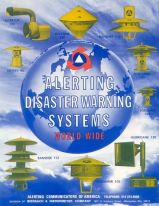
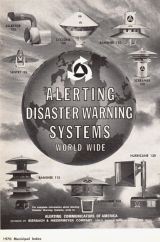
The company's siren division was reformed into the Alerting Communicators of America, led by James Biersach, who quickly designed several new outdoor warning sirens in an attempt to claw back the sales lost due to competition from companies such as Federal Sign & Signal. These sirens were quickly found to be reliable, powerful and easy to maintain, and differed from other manufacturers through their innovative used of fiberglass construction, which was lighter and was much more resistant to corrosion and weathering than steel. In 1968, the company would release its first line of sirens, which would see many sales across the United States and the company quickly established a strong foothold in the market, challenging Federal's dominance. ACA would redesign many of their sirens between 1972 and 1973, fixing a variety of issues that older designs had. Sales continued to rise, with the company often being contracted for both storm siren systems and nuclear plant siren systems. The company would remain producing the same siren models up until 1980, when the company began to streamline its lineup and introduced the Penetrator series of sirens, which proved to be easily the most popular sirens sold by the company.
Some siren models, such as the Allertor 125 and Hurricane 130, were discontinued and replaced by superior models. By the mid 1980s, the company also began to experiment with electronic sirens, which had become popularized by Whelen Engineering and Federal Signal at the time. However, ACA quickly began to run into problems in the mid to late 1980s. Their electronic sirens, known as the Alertronics, were proving to be unpopular, and sales were also waning once more thanks to increasing competition from the likes of Sentry Siren, Federal Signal, and Whelen Engineering. By 1988, Federal Signal had introduced the 2001-SRN, which was able to use DC battery backup while matching or outperforming ACA's offerings. ACA attempted to create their own DC sirens to compete, but they proved to be expensive, bulky, and chewed through batteries quickly. Federal quickly became completely dominant, shutting ACA out of the market as the quality of ACA's sirens began to suffer. Whelen also completely prevented ACA from gaining a foothold in the electronic siren market, as their WPS-2800 and WS-3000 sirens proved far better than the Alertronics. The final straw for ACA happened in November 1992, when BNCO, the parent of ACA, went bankrupt.
Having faced great competition, as well as Saudi Arabia refusing to pay for a large order of Cyclones, the company was no longer able to stay afloat. With heavy regrets and reluctance, BNCO decided to sell ACA off in order to recoup costs to pay off its debts. In 1993, HÖRMANN Warnsysteme became interested in purchasing ACA to gain a foothold in the US siren market. ACA showed off many of its newer sirens at its facility in 1993, which sealed the deal after impressive results. Soon after, the company would be purchased by HÖRMANN, and would be reformed into American Signal (ASC) the same year, operating alongside HÖRMANN America. Many of ACA's sirens would be discontinued while others would be carried on into ASC, and ACA would ultimately come to an end. A few members of ACA split off to form Excel Alerting Systems in 1997, which produced the Tempest-128 (originally designed in 1993) until the company absorbed the failing American Signal. Today, American Signal can be seen as a direct continuation of ACA, as the Tempest series of sirens are all based on an ACA design and are run by the same people who ran ACA. Thus, even though ACA itself is long defunct, its sirens continue to warn the public of danger, both old and new.
Products
Rotational
Allertor 125
See article: Allertor 125
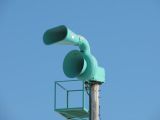
The Allertor 125 is a rotational, electromechanical civil defense siren that was produced from 1968 until it was replaced by the similar Penetrator series in 1980. The Allertor was the direct successor to BNCO's Mobil Directo siren, with significant improvements to the design which simplified manufacturing and enhanced the siren's durability and performance versus its predecessor. Like the Mobil Directo, it is unique in that it sucks in air through the bottom intake horn, and then the sound comes out of the top horn of the projector. In 1980, the Allertor was redesigned into the Penetrator-10 and 15, which replaced the giant projector with a simple horn and intake, which reduced costs and got rid of a lot of the Allertor's problems such as snow and ice building up inside the projector, and difficulty of installation. However, the Allertor's design offered superior performance. The Allertor was sold alongside the P-10 before it was finally discontinued, as it can be seen in ACA's 1983 catalogue. Despite its discontinuation, the siren was still supported by ACA and later ASC, with manuals and parts still being available for these sirens for a period of time, likely until the discontinuation of the RM-127 in 2004.
Howler
See article: Howler
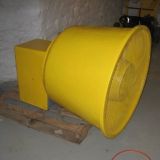
The Howler is a rotational, electromechanical siren that was produced in the 1970s and 80s, as an attempt to produce a cheaper rotating siren that didn't have the same issues the larger Allertor 125 had. Unfortunately, rotator issues, along with being completely overshadowed by the Allertor and later the Penetrator-10 led to this siren selling few units despite its long production run. The Howler was introduced in 1972, the same year that the Allertor 125 received its 3rd generation redesign. It was found that the Allertor was prone to letting water into the projector drum which would then get trapped and freeze, which led to the rotor getting frozen stuck and burning out the motor. ACA decided to create a new siren platform that made use of a one-piece projector rather than the massive 2-piece projector of the Allertor, which would be not only cheaper, but also solve the icing problems. This siren would become the Howler. The Howler would be discontinued in 1989 due to low sales. Only a single Howler remains in service today, which is located in Cologne, MN.
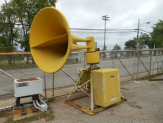
Hurricane 130/130 MKII
See article: Hurricane 130
The Hurricane 130 is a rotational, electromechanical siren designed by James E. Biersach, unveiled in 1968. Starting out with a square horn and an internal design that bottlenecked the siren's performance, the Hurricane went through many changes in design, sound, and overall functionality, despite being in production for only just over 10 years. The Hurricane 130 was heavily inspired by Federal Sign & Signal's Thunderbolt, which had been seeing great success, and ACA wanted a siren which could compete with its performance. Like all of ACA's other sirens such as the Allertor, Cyclone, Screamer and Banshee, the Hurricane made use of all-fiberglass casting, which was brand new and prevented the siren from corroding from the elements.
The siren originally used a square horn and a rotator that spun with the rest of the siren and went through a few design changes throughout its production. In 1973, the siren underwent a massive overhaul, called the "Hurricane 130 MKII" by ACA. The square horn was replaced with a much larger round, exponential horn ending in two throats, which performed significantly better. In addition, the rotator would be redesigned again, now being completely stationary, and now in a teardrop shape. The company continued production of the Hurricane until 1980, when it was replaced in ACA's lineup with the significantly more powerful 50 hp ACA Penetrator-50, which proved to be both louder, and more reliable without the need for a blower. These sirens often suffered from reliability issues often due to poor maintenance, and due to their complexity. This often led to their malfunction, failure, or replacement. The Hurricane is extremely rare today, with a single unit left in service.
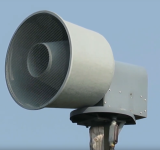
Penetrator
See article: Penetrator series
The Penetrator is a series of rotating electromechanical sirens that mainly consisted of 4 models: The P-10, P-15, PN-20, and the P-50. The Penetrator series proved to be one of ACA's most popular sirens throughout the 1980s for their reliability and output, and many can still be found in service today. The largest model, the Penetrator-50, holds the title of loudest electric siren in the world at 135 dB at 100 ft.
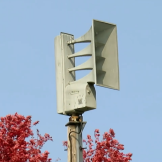
Alertronic
See article: Alertronic series
The Alertronic is a line of omnidirectional and rotational electronic sirens. An ambitious attempt to compete in the budding electronic siren market in the 1980s, it was always the underdog in its market but made up for it with its quirks. The Alertronic series was introduced in 1983 as ACA's first fully electronic warning system. These were intended to compete in the electronic siren market against Whelen Engineering's popular WS-2000 and WS-3000 sirens and Federal Signal's EOWS series, which were seeing much success at the time. The Alertronics would meet their end in 2011, when they were replaced by the E-Class and i-FORCE.
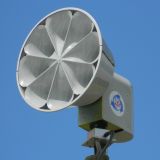
Tempest-128
See article: Tempest series
The Tempest-128 is a rotational, electromechanical siren, which although is mainly known for being produced by American Signal, was originally designed in 1993 by ACA. It was likely intended to replace the Penetrator sirens and compete with the Federal Signal 2001, but HÖRMANN refused to put the siren into production. As a result, the siren would not be released until 1997 under Excel Alerting Systems, before being sold by American Signal after Excel acquired it. The Tempest-128 is still in production today.
Omnidirectional
Screamer
See article: Screamer
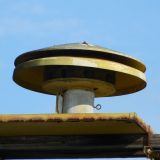
The Screamer is a series of small omnidirectional sirens that is the smallest of ACA's omnidirectional sirens (not including the short-lived Sentry 95), with the larger Banshee and Cyclone sirens being sold alongside them. Later produced by ASC under the OM Series, the Screamer would be replaced by the Tempest omnidirectional sirens in 2004. The Screamer is a very simple siren in design, with a motor of variable horsepower attached to a mounting bracket, that drives the rotor. Screamers come with a fiberglass weatherproof shroud that protects the siren from the elements, with the shape differing depending on the model. The siren intakes from above with a rotor-over-motor configuration, something that differs it from more powerful ACA models. The rain shield and skirt project sound from the intake, while the skirt projects the output from the rotor evenly. Several eyebolts are placed on the rain shield in order to facilitate easier mounting. This simple construction makes them relatively maintenance-free.
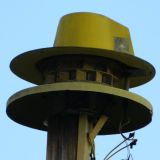
Banshee
See article: Banshee
The Banshee is a series of midrange omnidirectional mechanical sirens that was produced over a span of nearly 40 years. Released onto the market in 1968 alongside the smaller Screamer series and the powerful Cyclone, the Banshee was a popular option for an omnidirectional siren, competing with Federal Signal's STH-10 and SD-10, as well as Sentry's smaller omnidirectionals. The siren was offered in single or dual rotor configurations, with the dual rotor variant being known as the "SuperBanshee". In 1989, ACA experimented with a DC battery backup variant of the Banshee 115, known as the "Performance Plus" Banshees, and were sold alongside the Performance Plus Penetrators to compete with Federal's 2001 and the various electronic sirens available at the time such as the Federal Signal EOWS and Whelen WPS-2700 and 2800 that boasted DC power with battery backup, and were proving to be very popular. After ACA became ASC in 1994, the siren was renamed to the OM-120.
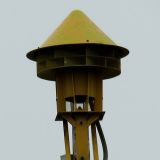
Cyclone
See article: Cyclone
The Cyclone is a powerful dual tone omnidirectional siren that at the time of its release was the most powerful and loudest omnidirectional siren on the market, and to this day still trades blows with much newer sirens such as Sentry's 20VXT and 40V2T, and ASC's T-121. It was the loudest omnidirectional siren ACA offered, being sold alongside their Screamer and Banshee sirens. The Cyclone, along with the P-50, would have the longest production run of any ACA-era siren, being produced for nearly 50 years. The Cyclone is a simple siren in design, with the intake being on the bottom where the siren is mounted. All Cyclones use an 8/12 port dual tone rotor and stator, with the motor being located on top. All Cyclones use the same rotor, which is a unique "dual-intake" design which was also used on Federal's 10/12 500-SHTT models which maximizes airflow to both rows of ports. This design is heavy and drags a lot, which requires the siren to use a very powerful motor. Like all of ACA's sirens, the Cyclone uses a fiberglass housing that protects the siren from corrosion, giving it exceptional longevity.

Sentry 95
See article: Sentry 95
The Sentry 95 was a short-lived siren that is a rebranded version of Klaxon Signals' SS6 siren, with the only difference between the two being the Sentry 95 having a rain shield included. It is unknown whether or not this siren ever actually made it to production and sold to customers, as none have ever been documented. It was discontinued after 1970 after a failed redesign attempt to attract customers.
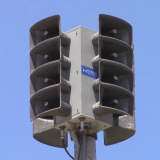
Alertronic
See article: Alertronic series
The Alertronic series is a line of electronic sirens that was an ambitious attempt to compete in the budding electronic siren market in the 1980s, it was always the underdog in its market but made up for it with its quirks. The Alertronic series was introduced in 1983 as ACA's first fully electronic warning system. These were intended to compete in the electronic siren market against Whelen Engineering's popular WS-2000 and WS-3000 sirens and Federal Signal's EOWS series, which were seeing much success at the time. The Alertronics would meet their end in 2011, replaced by the E-Class and i-FORCE.
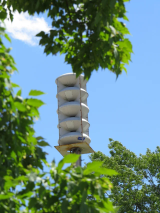
Quadren
See article: i-FORCE
Released in 1992, the Quadren is a very unique siren designed to act as both a directional *and* an omnidirectional siren, whichever is required. While similar in appearance to a Modulator or a Whelen omnidirectional, its internal design is completely different. Unlike other stacked-cell sirens, the Quadren only has speaker compression drivers in every other cell, with the sound being projected out of both the top and bottom of each active cell using horns inside the cells. Each active cell has half of a dummy cell on the top and bottom which forms an entire dummy cell in between each active cell when stacked, which forms the projectors through its shape. Like all of ACA's sirens, the cells are made of weather and corrosion-resistant fiberglass. Each active cell quadrant has a removable panel to easily access and replace faulty drivers. Each active cell in a Quadren is formed by four separate quadrants, which when 4 of them are put together form an entire cell. Each quadrant contains 4 100 W speaker compression drivers, meaning that a fully formed cell with 4 quadrants will have 16 100 W drivers. The siren was designed in a way where it could be cut in half or even in quarters to be mounted on walls or corners, instead of just on a pole. This made them more versatile, and they could be installed just about anywhere. The Quadren would be sold under ASC until 2005, when it was redesigned to its current form, the ASC i-FORCE.
